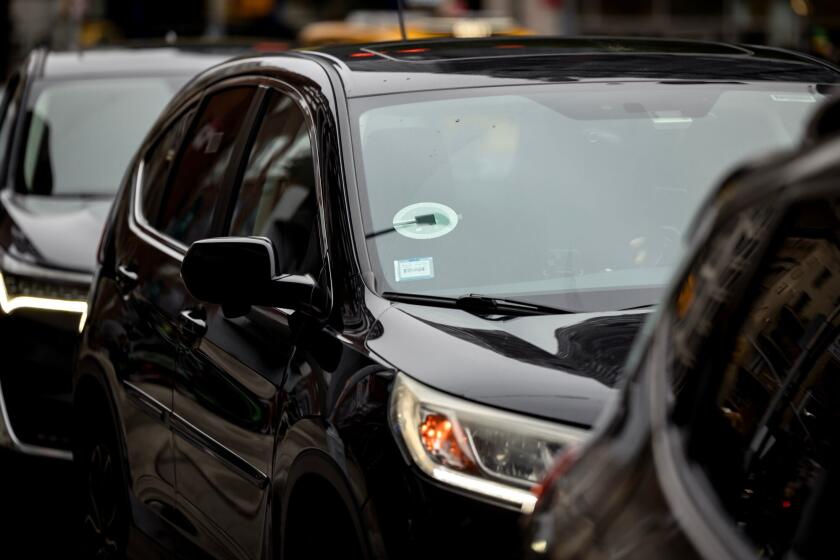Hop In and Drive ‘Em, Urban Cowboy
- Share via
We buy four-wheel-drive vehicles, goes a theory common to those who sell them, because they set our images somewhere between rugged naturalist and urban conqueror.
In truth, according to spokesmen for Jeep, Ford, Suzuki and others, fewer than 10% of 4WD owners tackle terrain any hairier than a dirt parking lot.
Therefore, with prices for even mid-market sport-utility vehicles with minimal options routinely topping $25,000, looking the part of an asphalt cowboy becomes a somewhat expensive vanity.
Which is precisely why Isuzu built the Rodeo.
It is high-riding and big-wheeled, and it has the look of the quintessential stump puller. Tires are Wrangler ATs, which stands for All-Terrain, and you can’t get farther off road than that.
Rodeos come with cargo nets and mirrors the size of portable TVs. Light bars and kangaroo catchers are available. The ride is a chunky swagger on alloy wheels built for sod thumping.
And it’s all show.
This sport-utility is two-wheel drive.
The entry-level Rodeo is sold with a four-cylinder engine providing the towing power of a Ford Escort.
Its off-road travel should be restricted to the back nine at Lakeside.
On the other hand, the base model Isuzu Rodeo S costs only $12,500. The step up to the Rodeo XS, with a heftier V-6 and most of the toys, can be made for $16,600. And for Wild Turkey drinkers, there is a full-house Rodeo LS, with the big engine and 4WD and all but frivolous options, for $18,000.
Isuzu--manufacturers of the scampish Amigo and the boxier, much more serious 4WD Trooper--estimates that 60% of its Rodeo buyers will choose the two-wheel-drive version. Some buyers are expected to switch from Trooper to the Rodeo after realizing they didn’t need 4WD anyway and their tastes run closer to sporty than utility.
With 2WD, there’s an immediate saving of $1,500 on the higher cost of four-wheel transmission. Insurance is also less on vehicles that aren’t likely to tip over west of Rock Spring Peak in deepest San Benito County.
“So the real (off-road) guy is going to buy a Trooper,” said an Isuzu spokesman. “A Rodeo guy is a family man with budget considerations who still wants that feeling of looking like he drives a four-wheel-drive . . . without having to stop on the freeway to lock the hubs.”
There is no doubt that all the look and lure of being able to do it in the dirt is with the LS. This Rodeo (that’s Roe-day-oh or Road-ee-o depending on how many vacations you’ve spent in Arizona) is long and broad of back. It has dungeons for wheel wells indicating a suspension that probably wouldn’t bottom out if the vehicle was dropped into the Grand Canyon.
The hood is squat and square with purpose. Bold edges and sharp corners have been rounded to satisfy mall denizens. But doors are tall and swing wide, and enough of the slab-sided look remains to suggest that this is a vehicle of much sporting and multiple purpose in the utility field.
Those Good Year Wranglers certainly don’t hurt the image. They were the tires worn by Walker Evans’ Dodge Ram that won this year’s Spring Run 101 off-road race.
Yet it would be quite unfair to stack all these visuals against the Rodeo’s two-wheel-drive performance and see the vehicle as some posturing pretender.
It might not have the horsepower, say, of a Jeep Cherokee, but its V-6 does indeed put out the oomph found in larger imported crew cabs. That gives it a Class II towing capacity or a maximum load of 3,500 pounds--comfortable and close to the vehicle’s curb weight.
Interiors certainly have nothing to do with performance, and the living space of the LS, although not super luxurious and several levels of aristocracy beneath Range Rover, is as good as any of its harder laboring brethren.
Broad bucket seats are tall, imperial and recline for picnic snoozes. Installing a bench up front provides easy seating for six.
With cushions unlatched and folded against the backs of the front seats, the split-rear seating folds down into a flat cargo area. It is more than four feet across and almost six feet long, and converts in seconds with no broken fingernails.
Access is by clamshell rear doors--a button to release the top half, a standard handle for the bottom portion--with the lower folding flat to a standard tailgate. An easy operation and, again, no mashed fingers.
But some suggestions: That cargo area would have more usable space if Isuzu went to a quick release for temporary removal of the spare tire. Relocating the rear speakers for the sound system would also create additional sliding and shoving room for uneven and multiple loads.
Up front, in the dash and its surrounds, there is a warren of openings and compartments (including a nifty secret locker in the center console) for meter change, sunglasses and emergency dog cookies.
But no cup holders. Nor very much of anything in the doors beyond two small bins for the odd prune Danish. A strange blemish on a vehicle geared to a lifestyle of several kids, the great outdoors and a thermal cup of coffee on the way to work.
Instrumentation is large, basic and quite friendly, and the workmanlike, leather-covered steering wheel tilts to a wide variety of positions.
Performance, of course, is precisely what we have come to expect from the sport-utility generation. That’s much groaning and roaring during initial acceleration, with the immediate scenery passing in slow motion. A manual transmission should snip a few seconds off that process.
Once on the road and rolling, however, power in the mid to upper ranges is quite adequate. especially if you stay on top of the engine, keep it perking and don’t let the power get down into the sludge again.
Yet such a heavy shoe can be expensive. Above the engine note of the Rodeo often comes another sound: It is a distinctive slurping between gas tank and injectors. In pre-invasion-of-Kuwait days, that might not have mattered. But with the Rodeo’s 22-gallon tank and today’s pump prices, you could be looking at a $30 fill-up.
On a vehicle with this much freeboard above a short wheelbase and a standard suspension, body roll is ever present. But unlike some others in its market segment, the Rodeo does not have that Dramamine pitch. And its shallow wallow is easily dissipated by gentlemanly use of brakes and steering.
It must not be forgotten, of course, that despite its rural kisser and physique, a two-wheel-drive Rodeo is no backwoods athlete to be teased into the wet and slipperies. Or is it?
During our test, an August monsoon thundered across the basin until two lanes of a late-night stretch of the westbound Ventura Freeway at Laurel Canyon were flooded.
We saw the 100-yard lake too late and plowed in at speed.
Stay off the brakes. Hold everything firm and straight. Just maintain the lane and line that was there before water blasted over the windshield.
Then we were through. The Rodeo did it without losing direction or deciding to hydroplane. Just like a 4WD.
Ahead was a litter of vehicles. A Honda Accord. A sport coupe of some sort. An elderly Celica.
All showing emergency flashers. All flooded out.
The Rodeo just shook off the rain like a wet cowhand and galloped on.
1991 ISUZU RODEO LS. COST
* Base, for Rodeo S: $12,499
* As tested, Rodeo LS.; $16,648
* (includes air conditioning, sunroof, cruise control, V-6 engine, automatic, central locking, tinted glass, power windows) *
ENGINE
* 3.1 liter, V-6, 12-valve developing 120 horsepower
TYPE
* Five-door, six-passenger, 2WD sport-utility vehicle
PERFORMANCE :
* 0-60 m.p.h. (as tested, with automatic) 13.9 seconds
* Top speed not available
* Fuel economy (as tested) city-highway average 17 m.p.g.
* CURB WEIGHT
* 3,820 pounds.
* THE GOOD
* Look and cool image of 4WD at econocar prices.
* Good heft, much space, high comfort.
* Effortless conversion from Little League to cargo carrier.
* High value vehicle.
* THE BAD
* With automatic, dozy acceleration from rest.
* Usable cargo space blocked by spare wheel and speakers.
* A gas-gulper with little concern for Middle East tensions.
THE UGLY
* Sport-utility wagons weren’t built to be beautiful.




